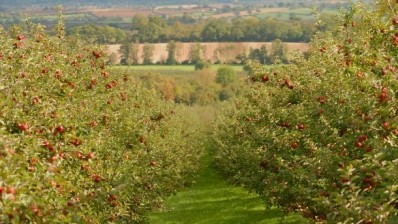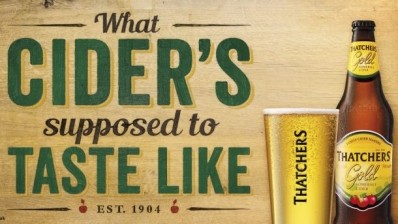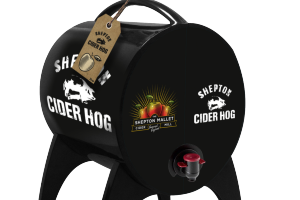Cider Trends Summit
Cider looks to emulate craft beer

Quality craft cider a hit at award-winning pub
Unique Bristol pub the Apple has used the growing popularity of cider to drive sales, pulling 17,000 pints of draft cider in April alone.
Owner Stephen Lyle told delegates that the heritage and authenticity of cider was appealing to consumers. “Drinkers are becoming more adventurous. They want to know what’s special, who’s making it,” he said. “We are seeing a reduction in the sales of fruit ciders as their authenticity is questioned a bit. Customers want a more sophisticated brand.”
Lyle has enjoyed 35% growth in sales at the Apple since it won Best Cider Pub at the Great British Pub Awards last year. With two of its three bars located on the permanently moored boat, the Apple is “all about putting quality, craft-produced cider into a modern context, an environment where everyone can enjoy it”.
It serves nine draft ciders and 40 bottles, ploughman’s sandwiches as an “excellent complement to cider”, cider lollies, and cider cocktails. The Apple also serves five mulled ciders in winter to boost trade.
‘Work together to grow category’
Heineken UK’s innovation director Sam Fielding urged the industry to work together to project messages of heritage, authenticity and quality to consumers.
The company uses apples from about 10,000 acres of orchards and aims to have 60% sustainably produced apples delivered to its mill, working with growers and farmers in Herefordshire.
“Apple has got a little bit lost in the debate about flavour. There’s a real opportunity to excite people about apples,” he said. “It’s about traditional cider making.” Fielding claimed Heineken’s recently launched Strongbow Cloudy Apple cider will get more cash through licensees’ tills. “There’s a growing demand for good draught cider,” he added.
However, Fielding argued it was also important for pubs to offer choice with their ciders. “Strongbow Dark Fruit was the single biggest innovation in any category last year.” It’s now the third biggest-selling draught cider following it’s on-trade roll out last year.
He added that innovative flavours such as Bulmers Zesty Blood Orange aimed to excite and bring people back to drinking cider.
NACM attempts to define ‘craft’
Craft beer and craft cider should be defined by the time and skill of the person that creates it, according to National Association of Cider Makers (NACM) chair Martin Thatcher.
Thatcher told delegates: “Craft beer and craft cider should work along the same lines as a cooper, who spends years learning his craft before becoming a ‘craftsman’. If you have been making cider for a long period of time, and you’re at the pinnacle of your expertise, then you have become a craftsman too and therefore what you make is a craft product.”
Thatcher welcomed recent Government support for the industry in the form of a duty cut in March’s Budget, but added that he would be pushing for a further cut to allow the industry to thrive.
“I think it [the duty cut] was tremendously important and all of the cider makers within the NACM worked tirelessly to achieve it. A lot of people will not have been aware of how long it took to prepare our case for the Treasury. I have to say that we are still slightly disappointed and need a further cut to close the duty differential with beer. The 2% cut was great, but we would really like another 2%,” he added.
Cider ‘must learn lessons of craft beer’
A senior drinks analyst advised cider makers to learn from the mistakes and triumphs of craft beer. Mintel’s Chris Wisson said that in the past 18 months, the beer category had “bounced back” and cider sales had stalled.
“We should define craft cider while it’s in its infancy, it’s up to the industry to work together to protect this,” he said. “The misused term could become meaningless. Look at beer where 36% of drinkers are unsure of what craft beer means.”
Cider makers should tell consumers why the brand is premium, through focusing on the amount of juice content, type of apples used, if they are hand-picked and the skills used.
He advised producers to look to innovative brands in other drinks categories and their packaging, and learn from the rejuvenation of cans.
Wisson warned against cider makers “pushing flavour innovation too far”, and said the market should learn from the swift decline of RTD sales.
Healey’s diversifies to grow
Healey’s Cyder has a long-term plan to grow its business by diversifying between tourism, cider making, soft drinks, whisky and jam.
“We want to produce long-term, sustainable profits, but the key terms here are ‘long-term’ and ‘sustainable’. We’re not here to make a quick buck, we are going to do the right thing by our business,” said Joe Healey, commercial director for the independent family-run business. “When you put your name on something, you really think about what it is you want it to deliver.”
The business — which makes Rattler cider among others — opened a new £3.4m production facility and visitor centre earlier this year and has enjoyed a boost in visitor numbers, which it has used to showcase its range of ciders and other products.
“It’s not exactly new for a cider maker who presses fruit to make juice, but we have made whisky and jam, as well as running a farm and tourist facility. Not bad for a cider maker,” he added.
Healey said the company was currently in its “second generation” but had “every ambition to become third and fourth generation”.
Cider offers gluten-free option
Cider is a good option for drinkers looking for a gluten-free alternative to beer, and that provides a great opportunity for pubs, according to the head of the US Cider Association.
“There has been a big movement in health, and gluten seems to be something that people want to get out of their lives,” said Mike Beck, who owns Uncle John’s Cider Mill, in Michigan. “The common beer drinker can find wine a bit unapproachable and a bit highbrow. Cider is often packaged in a bottle or is on draught at the pub. It is a much easier transition for people looking for something gluten-free to pick cider over wine.”
Beck reminded delegates that cider is becoming a more discerning choice for so-called millennials (born between 1980 and the early 2000s) who are interested in the ingredients and traceability of the product and are trading up from mainstream beers.
“Young folk are drinking this product. They’re college-educated and they’re buying local,” he added. If cider was a beer style in the US, it would be the second best-selling, such is its growth in popularity in recent years. Cider sales in the US have grown by about 65% each year in the past three years, Beck added.
10 things we learnt from the Cider Trends Summit
- 46% of UK adults regularly drink cider
- The category is worth £2.7bn in value across the on and off-trade
- Heineken UK uses apples from 10,000 acres of orchards
- Half of all 18 to 24-year-olds drink flavoured cider
- India grows a third of the world’s apples but two thirds of those are unused
- Just 58% of cider drinkers are satisfied with the draught range in pubs
- Healey’s attracts 400,000 visitors annually to its farm in Cornwall
- Some 92 new cider products were introduced to the on-trade last year
- If cider was a beer style in the US, it would be the second most popular
- Sales at the Apple Cider Boat in Bristol have grown by 35% following its win at the Great British Pub Awards
Westons’ head of sales Geoff Bradman warned the industry against the misuse of the term premium, as “savvy” customers meant that brands would be caught out.
Drinkers are driven by a balance between economisation and premiumisation and the cider market had benefited greatly over the past five years, he argued.
“To be true premium brands must offer consumers genuine benefits over others,” he said. “Premium is a much-misused phrase. It must be held in high esteem, be better quality, better value and superior to competitors.”
Brands must demonstrate a difference otherwise consumers will “catch us out”, he added.
He said 92 new cider products were launched into the on-trade last year, about three-quarters of which were classed as premium.
“Premium cider is incredibly popular in the market,” he said, adding that about half of all cider serves are now premium, compared to about a third of lager serves.
The premiumisation trend is set to continue with forecasts for continuing market growth in the next five years.












